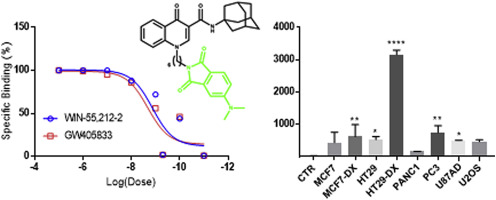当前位置:
X-MOL 学术
›
Eur. J. Med. Chem.
›
论文详情
Our official English website, www.x-mol.net, welcomes your
feedback! (Note: you will need to create a separate account there.)
Design and synthesis of fluorescent ligands for the detection of cannabinoid type 2 receptor (CB2R).
European Journal of Medicinal Chemistry ( IF 6.0 ) Pub Date : 2020-01-07 , DOI: 10.1016/j.ejmech.2020.112037 Francesco Spinelli 1 , Roberta Giampietro 1 , Angela Stefanachi 1 , Chiara Riganti 2 , Joanna Kopecka 2 , Francesca Serena Abatematteo 1 , Francesco Leonetti 1 , Nicola Antonio Colabufo 3 , Giuseppe Felice Mangiatordi 4 , Orazio Nicolotti 1 , Maria Grazia Perrone 1 , José Brea 5 , María Isabel Loza 5 , Vittoria Infantino 6 , Carmen Abate 1 , Marialessandra Contino 1
European Journal of Medicinal Chemistry ( IF 6.0 ) Pub Date : 2020-01-07 , DOI: 10.1016/j.ejmech.2020.112037 Francesco Spinelli 1 , Roberta Giampietro 1 , Angela Stefanachi 1 , Chiara Riganti 2 , Joanna Kopecka 2 , Francesca Serena Abatematteo 1 , Francesco Leonetti 1 , Nicola Antonio Colabufo 3 , Giuseppe Felice Mangiatordi 4 , Orazio Nicolotti 1 , Maria Grazia Perrone 1 , José Brea 5 , María Isabel Loza 5 , Vittoria Infantino 6 , Carmen Abate 1 , Marialessandra Contino 1
Affiliation

|
The Cannabinoid 2 receptor, CB2R, belonging to the endocannabinoid system, ECS, is involved in the first steps of neurodegeneration and cancer evolution and progression and thus its modulation may be exploited in the therapeutic and diagnostic fields. However, CB2Rs distribution and signaling pathways in physiological and pathological conditions are still controversial mainly because of the lack of reliable diagnostic tools. With the aim to produce green and safe systems to detect CB2R, we designed a series of fluorescent ligands with three different green fluorescent moieties (4-dimethylaminophthalimide, 4-DMAP, 7-nitro-4-yl-aminobenzoxadiazole, NBD, and Fluorescein-thiourea, FTU) linked to the N1-position of the CB2R pharmacophore N-adamantyl-4-oxo-1,4-dihydroquinoline-3-carboxamide through polymethylene chains. Compound 28 emerged for its compromise between good pharmacodynamic properties (CB2R Ki = 130 nM and no affinity vs the other subtype CB1R) and optimal fluorescent spectroscopic properties. Therefore, compound 28 was studied through FACS (saturation and competitive binding studies) and fluorescence microscopy (visualization and competitive binding) in engineered cells (CB2R-HEK293 cells) and in diverse tumour cells. The fluoligand binding assays were successfully set up, and affinity values for the two reference compounds GW405833 and WIN55,212-2, comparable to the values obtained by radioligand binding assays, were obtained. Fluoligand 28 also allowed the detection of the presence and quantification of the CB2R in the same cell lines. The interactions of compound 28 within the CB2R binding site were also investigated by molecular docking simulations, and indications for the improvement of the CB2R affinity of this class of compounds were provided. Overall, the results obtained through these studies propose compound 28 as a safe and green alternative to the commonly used radioligands for in vitro investigations.
中文翻译:

设计和合成用于检测2型大麻素受体(CB2R)的荧光配体。
属于内源性大麻素系统ECS的大麻素2受体CB2R参与神经变性和癌症进化与进展的第一步,因此可在治疗和诊断领域中利用其调节作用。然而,由于缺乏可靠的诊断工具,在生理和病理条件下CB2Rs的分布和信号通路仍存在争议。为了产生一种绿色安全的系统来检测CB2R,我们设计了一系列具有三个不同绿色荧光部分(4-二甲基氨基邻苯二甲酰亚胺,4-DMAP,7-硝基-4-基-氨基苯并二唑,NBD和荧光素-硫脲(FTU)通过聚亚甲基链连接到CB2R药效团N-金刚烷基-4-氧代-1,4-二氢喹啉-3-羧酰胺的N1位。化合物28的出现是因为它在良好的药效学性质(CB2R Ki = 130 nM,与其他CB1R亚型之间没有亲和力)和最佳荧光光谱性质之间折衷。因此,通过FACS(饱和和竞争结合研究)和荧光显微镜(可视化和竞争结合)在工程细胞(CB2R-HEK293细胞)和多种肿瘤细胞中研究了化合物28。成功建立了氟配体结合测定,并获得了两种参考化合物GW405833和WIN55,212-2的亲和力值,与通过放射性配体结合测定获得的值相当。Fluoligand 28还允许检测相同细胞系中CB2R的存在和定量。还通过分子对接模拟研究了化合物28在CB2R结合位点内的相互作用,并提供了改善此类化合物的CB2R亲和力的指示。总体而言,通过这些研究获得的结果表明,化合物28是用于体外研究的常用放射性配体的安全和绿色替代品。
更新日期:2020-01-07
中文翻译:

设计和合成用于检测2型大麻素受体(CB2R)的荧光配体。
属于内源性大麻素系统ECS的大麻素2受体CB2R参与神经变性和癌症进化与进展的第一步,因此可在治疗和诊断领域中利用其调节作用。然而,由于缺乏可靠的诊断工具,在生理和病理条件下CB2Rs的分布和信号通路仍存在争议。为了产生一种绿色安全的系统来检测CB2R,我们设计了一系列具有三个不同绿色荧光部分(4-二甲基氨基邻苯二甲酰亚胺,4-DMAP,7-硝基-4-基-氨基苯并二唑,NBD和荧光素-硫脲(FTU)通过聚亚甲基链连接到CB2R药效团N-金刚烷基-4-氧代-1,4-二氢喹啉-3-羧酰胺的N1位。化合物28的出现是因为它在良好的药效学性质(CB2R Ki = 130 nM,与其他CB1R亚型之间没有亲和力)和最佳荧光光谱性质之间折衷。因此,通过FACS(饱和和竞争结合研究)和荧光显微镜(可视化和竞争结合)在工程细胞(CB2R-HEK293细胞)和多种肿瘤细胞中研究了化合物28。成功建立了氟配体结合测定,并获得了两种参考化合物GW405833和WIN55,212-2的亲和力值,与通过放射性配体结合测定获得的值相当。Fluoligand 28还允许检测相同细胞系中CB2R的存在和定量。还通过分子对接模拟研究了化合物28在CB2R结合位点内的相互作用,并提供了改善此类化合物的CB2R亲和力的指示。总体而言,通过这些研究获得的结果表明,化合物28是用于体外研究的常用放射性配体的安全和绿色替代品。











































 京公网安备 11010802027423号
京公网安备 11010802027423号